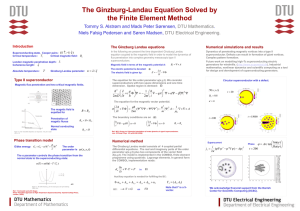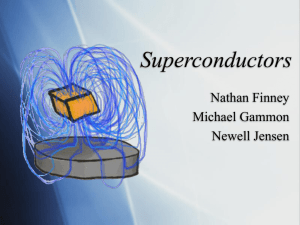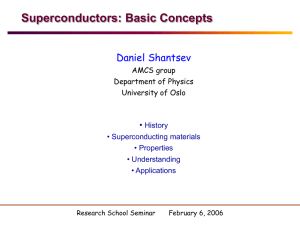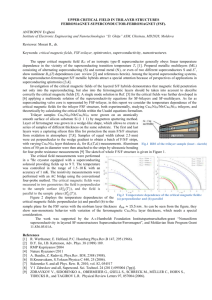Document 13608291
advertisement
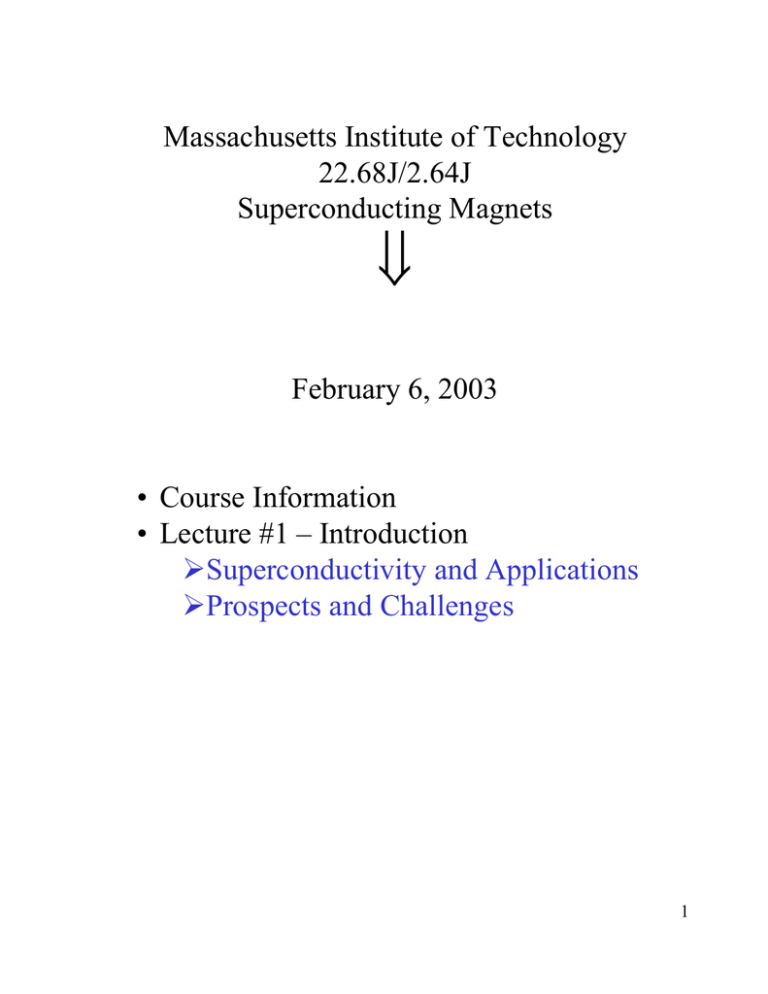
Massachusetts Institute of Technology 22.68J/2.64J Superconducting Magnets ⇓ February 6, 2003 • Course Information • Lecture #1 – Introduction ¾Superconductivity and Applications ¾Prospects and Challenges 1 Magnetic Field – Two Distinct Views Users’ (Physicists, Doctors, etc.) G B 2 Magnet Engineers Perspective 3 Electromagnets Current Carrying Wire: generates lines of magnetic flux (H.C. Oersted, 1819) Coil: Produces a bundle of magnetic flux Iron Electromagnet: The flux can be use to align magnetic domains in iron, producing ~1000 times as much flux. The iron will be saturated, limiting the maximum flux to ~2 Tesla. 4 High-Field Magnets: High Field (>2T) magnets are ironless electromagnets. There are basically three approaches for high-field electromagnets: 1) nonsuperconducting; 2) superconducting; and 3) hybrid-combination of 1) and 2). Nonsuperconducting • RT copper magnets, generally water-cooled. ¾ No inherent upper-field limit – only more power ( & cooling) and stronger materials required. ¾ Current record: 33T (~35MW) at NHMFL. • Cryogenic Cu or Al magnets, LN2-, LNe-, or LH2­ cooled. ¾ For special applications only – generally pulsed fields Superconducting • LTS Magnets, LHe-cooled or cryocooler-cooled. • HTS magnets. LHe-, cryocooler-, LN2-cooled. • Superconductor performance a key limitation. Hybrid • A copper magnet (inner section) combined with a superconducting magnet (outer section). • Current record: 45 (30Cu/15SC)T, at NHMFL. 5 High-Field Magnets 6 Types of Superconducting Magnet Solenoid: Cylindrical helices; most widely used type. Dipole: Generates a uniform field transverse to its long axis; deflects charged particles in accelerators and MHD. Quadrupole: Generates a linear gradient field transverse to its axis over the central region of its bore; focuses particles in particle accelerators. Racetrack: Resembles a racetrack; wound in a plane with each turn consisting of two parallel sides and two semi-circles at each end; a pair may be assembled to approximate the field of a dipole; used in motors and Maglev. Toroid: Generates a field in the azimuthal direction; it confines hot plasma in a Tokamak; also used for SMES. 7 Magnet Types, Maxiumum Fields, Applications Type Solenoid Dipole Quadrupole Racetrack Toroid Bmax [T] Application (partial list) 45a 23.5b 5c ~1.5+d ~15e 0f 4-5g ~16h 5-10i High-field research NMR MRI Magnetic Separation High-energy physics (HEP) HEP Power Electric Devices Fusion SMES a) Hybrid magnet (NHMFL). b) Future Target (1-GHz system); current record: 21.14 (900MHz). c) Or higher; more widely and universally used systems: 0.5-1.5T. d) HTS version. e) Future target:recent prototype (LBNL); current range: 4.8-5 (Large Hadron Collider-CERN). f) On-axis; peak field at the winding may reach ~8T for current systems. g) HTS motors and generators. h) Future target for power-generating systems. Present value 13T (ITER). i) Future range for HTS systems. 8 Superconductivity Heike Kamerlingh Onnes (1853-1926) “Door meten tot weten” (“Through measurement to knowledge”) 9 Superconductivity Facts on Superconductors • “Zero electrical resistance (R=0), under DC conditions. — Discovered by Kammerlingh Onnes (1911). • Some are “perfect” diamagnets (B=0) – Type I. — The Mesissener effect (W. Meissner and R. Oschenfeld, 1933). — Others are mostly diamagnets and R~0 – Type II. • There are two(?) types of superconductors. — Low-temperature superconductors (LTS) — High-temperature superconductors (HTS) — Medium-temperature superconductors (MTS)? 10 Superconductivity Discovered by Kamerlingh Onnes (1911) • “Zero electrical resistance (R=0), under DC conditions. • Dissipative under AC conditions. Normal Metal Current Superconductor Current Superconductor Current 11 Mesissner Effect (W. Meissner & R. Oschenfeld, 1933) • Some are “perfect” diamagnets (B=0) – Type I. — The Mesissener effect (W. Meissner and R. Oschenfeld, 1933). — Others are mostly diamagnets and R~0 – Type II. 12 Resistance vs Temperature Plots • Mercury (1911) • Y-Ba_Cu-O (c. 1987) 13 Facts on Superconductors (continued) • Superconductivity has three critical parameters: o Critical temperature, Tc o Critical magnetic Field, Hc o Critical current density, Jc. Critical Surface of a Superconductor 14 Perfect Conductor vs Superconductor • Perfect conductor: ρ = 0 → dB/dt = 0. • Perfect Superconductor: ρ = 0 and B = 0. 15 Why Superconductivity Discovered? • As a result of solid state physics research in the early 1910s. o In 1911 Kamerlingh Onnes of U. Leiden discovered Hg (Tc = 4.18 K) as a superconductor. o Discovered (1911) the existence of Jc with Hg. o The first superconducting (Pb wire) magnet failed (1913). o Received (1913) the Nobel Prize in physics for the discovery of superconductivity and the liquifaction of helium. o Discovered (1914) the existence of Hc, with Pb and Sn. 16 Why Superconductivity Discovered? (continued) • As a result of a long-sought desire to push Tc beyond 23.2 K, a stagnant limit since the 1970’s, and even reach 77 K, the boiling point of liquid nitrogen. o In April 1986, J.G. Bednorz and K.A. Muller of IBM (Zurich) discovered La-Ba-Cu-O, a layered copper oxide perovskite, a superconductor with Tc = 35 K. o In 9187, P.W. Chu and others at U. of Houston and U. of Alabama discovered YBaCuO (Y-123) or YBCO), Tc = 93K, also a copper oxide perovskite. o In January 1988, H. Maeda, of the National Institute for Metals (“Kinzai-Ken”), Tsukuba, discovered BiSrCaCuO (BSCCO); now in two forms: Bi-2212 (Tc = 85 K); and Bi-2223 (Tc = 110K). o In February 1988, Z.Z. Sheng and A.M. Hermann at U. of Arkansas discovered TlBaCaCuO (Tl-2223), Tc ~ 125K. o In 1993, Chu discovered HgBaCaCuO (Hg-1223), Tc ~ 135K (164 K under a pressure of 300 atm). o Since 1986 more than a hundred compounds of HTS have been discovered as well as USOs – Unidentified Superconducting Objects – “sighted”. 17 Progress of Tc 18 Two “Flavors” of Superconductors Type I • Exhibits the Meissner effect; B= 0 beyond “penetration depth,”, δ (F. and H. London, 1935) 19 Type II • Exhibits the “mixed” magnetic state. o Normal “islands” (“vortex”) of size “coherence ξ length” in a sea of superconductivity: R ~ 0. o Each votex contains one quantum of magnetic flux, Φo, the collection of which is known as the Abrikosov vortex lattice. (Φo≡ h/2e ~ 2.0 x 10-15 Tm2.) o Hc2 >>Hc and µoHc2 ~ Φo/ ξ2. • All high-temperature superconductors are Type II. 20 Schematics of Mixed State Superconducting electron density distribution: ns Coherence length: ξ Penetration depth: λ 21 Magnetization Plot with the Mixed State Magnetic Field vs Temperature Plots 22 Critical Surfaces 23 A Brief History ( •: science; Ä: technology) 1900s Ä Liquefaction of helium (Ts = 4.22 K), by KO (1908). 1910s Ä First liquid helium “cryostat” by KO (1911). • Discovery by KO of Type I superconductors (1911). Ä First SCM by KO failed (1913). 1930s • First Type II superconductor, W. de Haas and J. Voogd. • Meissner effect, by W. Meissner and R. Oschenfeld (1933). • Electromagnetic theory (“penetration depth” λ ), by F. and H. London (1935). 1940s Ä First “large-scale” helium liquifier, by S. Collins (1946). 1950s • “Coherence length” (ξ), introduced by A.B. Pippard. (κ ≡ δ / ξ > 1 / 2 ) • GLAG (Ginzburg, Landau, Abriskov, Gorkov) theory – magnetics of Type II superconductors . • Many A-15 (metallic superconductors, chiefly in the U.S. • Cooper pair, by L.N. Cooper (1956). 24 A Brief History (continued) 1950s • BCS (Bardeen, Cooper, Schreiffer) theory – microscopic theory of superconductivity (1957). • Flux quantization. Ä “Toy” superconducting magnets (SCM) (1956). Bcs_anim.gif 25 A Brief History (continued) 1960s Ä High-field, high-current superconductors (1961) - “pinning” of the “islands” (fluxoids). z Josephson tunneling, B.D. Josephson (1962). Ä Birth of superconducting magnet technology (mid-1960s). Ä Start of large SCM for research – MHD, HEP (R&D). 1970s Ä Maglev (“linear motor”) Ä Superconducting generators; transmission lines (R&D). Ä Commercial NMR magnets. Ä Fusion and particle accelerator magnets. 1980s Ä Commercial MRI magnets. z Discovery of HTS. 26 Pros and Cons of Superconductors Positive Aspects • R = 0 under DC conditions ¾ Can generate a large magnetic field. Dissipation = I2R = 0. ¾ Can generate a large magnetic field over large volumes. ¾ Can generate a “persistent” magnetic field. dB =0 dt 27 Driven System (I2R=0) Persistent-Mode System (dB/dt = 0) 28 Pros and Cons of Superconductors Negative Aspects • Tc << room temperature. ¾ Require refrigeration and good thermal insulation. • Mixed state (Type II). ¾ R ≠ 0, under time-varying conditions. • Expensive vs copper, aluminum, steel, organic materials. ¾ 100-1000 times more than copper. 29 Magnetic Field Spectrum 30 Temperature Spectrum 31 Applications of Superconductivity Energy • Generation & Storage Fusion; Generators; SMES; Flywheel • Transmission & Distribution Power Cable; Transformer; FCL • End Use Motor Transportation • Maglev Medicine • MRI; NMR; SQUID (biomagnetism); Magnetic Steering; Biological Separations Space & Ocean • Sensors; SQUID; Undersea Cables; Maglifter High Tech • Magnetic Bearings; SOR; Magnetic Separation Information/Communication • Electronics; Filters Research • NMR; HEP Accelerators; High-Field Magnets, Proton Radiography 32 Power Requirements for Copper Solenoids (at Room Temperature) • Power Required ∝ Resistivity x Diameter x Field2 33 For 1-T Whole-Body MRI Units: Superconducting vs Room-Temp Copper 34 Magnetic Pressure, Density, Force Magnetic Pressure 2 B Pm = 2µ o [N/m2] Where µo = 4π × 10-7 H/m and B in tesla. 35 Fusion The thermal or kinetic pressure, pk, of the plasma must be confined with the magnetic pressure, pm, exerted on the plasma by a magnetic field. The magnetic confinement of hot plasma requires that B2 f p = n k T << p = k p b p m 2µ o B2 n k T =β p b 2µ o 2µ n k T o p b p B= β With np = 1021 m-3, T = 108K, kB = 1.38 × 10-23 J/K and β = 0.05, B ~ 8.3 T (~ 10 T) Pm = 400 atm (10 T) Psun ~ 3 × 1011 atm ~ 3 × 105 T) 36 Maglev Pm = 4 atm (~ 1 T) Other support pressures [atm]: Shoes: Bicycle Tires: High-speed train steel wheels: 0.1 - 0.3 4–6 5,000 37 Magnetic Energy Density B2 Em = [J / m 3 ] 2µ o SMES (Superconducting Magnetic Energy Storage) B limited to ~ 5 T for practical considerations. Illustration: B = 5 T → em = 2 × 107 J/m3. Boston Edison has a peak-power demand, ∆Ppk-av, on a hot summer day of typically ~ 2,500 MW lasting (∆t) of ~10 h. Namely, ∆Epk ~ 2.5 × 109W × 10 h × 3,600 s/h ~1014 J Because Varena ~ 1 × 106 m3, the number of SMES units each the size of a large arena storing a magnetic energy of Earena ~ 2 × 1013 J: NSMES ~ 4 Arenas 38 Magnetic (Lorentz) Force FLorentz = (length) × I × B [Newtons] Electrical Devices: Generators and motors. B limited to ~ 5 T for practical considerations. 39 Magnetic Force on Elementary Particles High-Energy Physics Accelerators G M pv2 G M pc2 G E p G ir ≅ ir = ir Centrifugal force ≡ Fcf = Ra Ra Ra G G Centripetal force = Lorentz force ≡ F . l = − qcBz ir Ep Ra = qcBz Ra = Ep qcBz With Ep = 20 TeV (3.2 µJ), q = 1.6 × 10-19 C, c = 3 × 108 m/s, and Bz = 5 T, Ra ~ 13 km or a diameter exceeding 25 km. 40 Magnetic Torque on Nuclei Nuclear Magnetic Resonance (NMR) and Magnetic Resonance Imaging (MRI) G G G dµ γµ × H o = dt Larmor frequency ≡ fo = γHo Where γ is a gyromagnetic ratio. For hydrogen (proton): fo = 42.58 MHz/tesla. 41 Applications to Electricity 42 43 Applications to Electricity E/GNP ratio, energy consumption/GNP vs year Electricity fraction, electric energy/total energy vs year Both for the U.S. 44 Prospects – February 2003 Ê Ê Ê NN NN NN 45 Enabling vs Replacing Technology Feature Competitor Criterion Enabling Yes No Feature Replacing No Yes Cost 46 Does Superconductivity Make A Technology Enabling? 47 Stages of Development Towards a Commercial Product • Step-by-step progression from low to high grade. • Highly beneficial if the device is useful at each step. 48 Superconducting (NbTi) Particle Accelerators 49 Superconducting (NbTi) Particle Accelerators Large Hadron Collider at CERN, Geneva 50 Superconducting (NbTi) Particle Accelerators 51 Superconducting Magnets for Fusion See “Fusion Magnets” presentation 52 Challenges for Superconductivity Cons: Revisited • Tc << room temperature. ¾Require refrigeration and good thermal insulation. • Mixed state (Type II). ¾R ≠ 0, under time-varying conditions. • Expensive vs copper, aluminum, steel, organic materials. ¾100-1000 times more than copper. 53 1. Operating Temperature •All devices operate at room temperature Examples: motors,; camera; refrigerators; wrist watches; CD players, automobiles; pianos; airplanes; etc. •Exceptions: Superconducting devices. Challenge •Develop “magnet-grade” HTS that enable: Top = TRT (Room Temperature) 54 Operating Temperatures: HTS vs LTS Two Views •Reference temperature at 0 K: [Top ]HTS 80K ≈ = 20 [Top ]LTS 4K A 20-fold improvement. •Reference temperature at 22 C: [Top ]HTS − 291C ≈ = 1 .33 [Top ]LTS − 218C Only a modest 33% improvement. 55 Progress of Tc: Impressive but still a lot to go. 56 1. Operation at Cryogenic Temperature Refrigeration and thermal insulation required. • Refrigeration power – manageable. • Thermal insulation – fundamental hindrance. o Needed: quantum improvements in insulation techniques. Corollary • Proliferation of superconductivity nonlinear with Tc. 57 2. Mixed State (Type II) Illustration: Losses in Tapes Superconductor and copper under It = Io sin(2πfot). Superconductor at Top < TRT: Hysteresis Dissipation Density. f o µ o I t3 W [ phy Top = 3] 2 m 6w I c Copper at TRT: Ohmic Dissipation Density poh TRT ρ cu I t2 W = [ 3] 2 2 m 2w δ 58 Power Density Ratio phy Top poh TRT f oδ 2 ⎛ µ o ⎞⎛ I t ⎞ ⎟⎟⎜⎜ ⎟⎟ ⎜⎜ ≡ ξ ac = 3 ⎝ ρ cu ⎠⎝ I c ⎠ With fo = 60 hz; δ= 0.25 mm; ρcu = 2 ×10-8 Ωm; It/Ic = 0.5: ξac = 4 × 10-5 Observation: Hysteresis losses, though nonzero, are manageable with good refrigerators. 59 3. Conductor • • • • Performance improvement. Cost reduction. Top optimization. Operating mode. 60 Performance Requirements 61 Conductor Costs Cost/performance improvements for HEP and Fusion-type Nb3Sn wires 35 $/kA-m (12T, 4.2K ) 30 ITER 25 D20 20 KSTAR 15 RD-3 10 5 HD-1 0 1988 1990 1992 1994 1996 1998 2000 2002 Year 62 Cost of Silver-Sheathed Bi-2223 Tape (Normalized to 77 K Cost: 1/Jc|77K) 63 100-kW Refrigerator Performance 64 Optimum Operating Temperature • Jc(T) important. • Refrigerator performance vs T important. • Optimum Top: o ~15 K for systems with large refrigerators o Up to ~40 K for systems with cryocoolers o 77 K – probably NOT and optimum Top. o LN2 useful for high-voltage applications. 65



